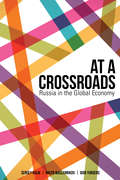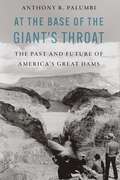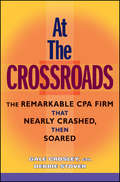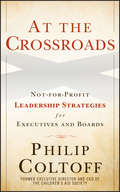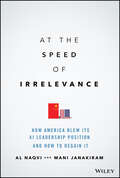- Table View
- List View
At Your Service?: The Promise of Services-Led Development
by Gaurav Nayyar Mary Hallward-Driemeier Elwyn DaviesManufacturing-led development has provided the traditional model for creating jobs and prosperity. But in the past three decades the conventional pattern of structural transformation has changed, with the services sector growing faster than the manufacturing sector. This raises critical questions about the ability of developing economies to close productivity gaps with advanced economies and to create good jobs for more people. At Your Service? The Promise of Services-Led Development (www.worldbank.org/services-led-development) assesses the scope of a services-driven development model and policy directions that can maximize the model’s potential.
At Zero
by Joe VitaleNew stories and new processes that outline the fourth stage of awakening of ho'oponoponoAuthor Joe Vitale's previous book, Zero Limits, presented a unique self-help breakthrough focused on helping overworked, overstressed individuals overcome obstacles and achieve their goals. It was the first book to explain how a secret Hawaiian method called ho'oponopono can help people experience health, wealth, happiness, and more. It empowered thousands of readers to take control of everything in their lives in order to achieve all they've ever dreamed of. At Zero starts where Zero Limits left off. It offers new stories, explains new process, and reveals the fourth stage of awakening.Explains the process called "cleaning," to delete programs and beliefs that you aren't aware ofShows how repeating the phrases I love you, I'm sorry, Please forgive me, Thank you can help you reach DivinityLife will always present you with challenges. The practice of ho'oponopono, as revealed by author Joe Vitale, guides you through the journey of life with the tools you need to rid yourself of hindrances and open yourself up to infinite possibilities.
At a Crossroads: Russia in the Global Economy
by Sergey Kulik Nikita Maslennikov Igor YurgensGlobalization proceeds apace, taking on new forms that impact global economic, financial and social processes. Interdependence is not simply strengthening the range of possibilities for national economies to participate in, and advantage of, these developments, but expanding the opportunities that are available to them. The question is how do states take advantage of these global developments. Russia is no exception. Although it actively participates in the globalization process, it is, however, confronting greater economic, technological, structural and institutional problems than other countries. At the same time, there is dwindling hope for favourable conditions to continue in global energy markets, which are crucial to the Russian economy. These problems exist alongside the risk that the widening gap between Russia and other economies in terms of economic performance and technological development and growth will continue. Russia now stands at the crossroads of either overcoming or exacerbating these current challenges. This choice dictates the current realities of pax economica. Moscow must, in the very near future, make meaningful, if not fundamental, decisions aimed at further opening its economy, improving its institutions, and strengthening its international ties. This task is made more difficult by Russia's weakening competitiveness and by its ambiguous position on the international division of labour. The old model of Russian development has been exhausted and a new one must be chosen. Russia's choice at this juncture will determine the future of its economic development for many years to come.
At the Base of the Giant's Throat: The Past and Future of America's Great Dams
by Anthony R. PalumbiThere are ninety thousand registered dams in the United States, fifty thousand of them classified as &“major.&” Nearly all of this infrastructure was built during a forty-year period, from 1932 to 1972, in an era of public investment and political consensus that seems inconceivable today. These incredible structures—sometimes called the American Pyramids—helped the country rebound from the Great Depression, brought water and electricity to enormous reaches, helped win World War II for the Allies, and became the basis for decades of prosperous stability.At the Base of the Giant&’s Throat dives into the history of dam-building in the United States as natural waterscapes have been replaced with engineered environments and the bone-dry West became America&’s produce aisle. From the Folsom Powerhouse cranking sixty-hertz alternating current in the 1890s to the iconic Hoover Dam and the gargantuan Grand Coulee Dam, Anthony R. Palumbi lays out how dams and water projects changed the North American continent forever and laid the groundwork for an age of unprecedented prosperity. He also describes how institutional complacency corrupted the ethos of public power and public works—and how the influence of rich landowners undermined the credibility of that ethos. Palumbi shows how our nation&’s ability to cope with natural disasters has been fatally compromised by underinvestment in decaying infrastructure. He argues that a livable future demands investment on a scale few Americans currently grasp. To win that future we must interrogate the history of our most vital public works: the dams, canals, and levees helping to channel life&’s most precious molecule.At the Base of the Giant&’s Throat tells the story of America through its water, sweeping across five hundred years of history, from the swashbuckling exploits of French colonist Samuel de Champlain to the nightmarish urban flooding of Hurricane Katrina and Hurricane Sandy.
At the Boundaries of Homeownership: Credit, Discrimination, And The American State
by Chloe N. ThurstonIn the United States, homeownership is synonymous with economic security and middle-class status. It has played this role in American life for almost a century, and as a result, homeownership's centrality to Americans' economic lives has come to seem natural and inevitable. But this state of affairs did not develop spontaneously or inexorably. On the contrary, it was the product of federal government policies, established during the 1930s and developed over the course of the twentieth century.<P><P> At the Boundaries of Homeownership traces how the government's role in this became submerged from public view and how several groups who were locked out of homeownership came to recognize and reveal the role of the government. Through organizing and activism, these boundary groups transformed laws and private practices governing determinations of credit-worthiness. This book describes the important policy consequences of their achievements and the implications for how we understand American statebuilding.<P> Proposes a new theory about the logic of policy expansion in the public-private welfare state and sheds light on the role of citizen groups and social movements.<P> Identifies and defines 'boundary groups' as a key player in twentieth-century housing policy.<P> Contributes to our understanding of the recent foreclosure crisis and provides historical context to evaluate the casual narratives that emerged in the wake of the crisis implicating low-income and minority borrowers.<P> Read more at http://www.cambridge.org/us/academic/subjects/politics-international-relations/american-government-politics-and-policy/boundaries-homeownership-credit-discrimination-and-american-state#2WZ0e4EhqHmm51Ke.99
At the Crossroads
by Gale Crosley Debbie StoverIf you'd like to know how to change your underachieving firm, At The Crossroads: The Remarkable CPA Firm That Nearly Crashed, Then Soared may hold the key to a bright new future. This innovative book is told in story form, drawing the reader behind the scenes of a dysfunctional team that applies Crosley?s Practice Growth Model to overcome the defects to produce a highly functional team.
At the Crossroads
by Philip ColtoffAn indispensable guide to the complex art of nonprofit leadership and management In The Challenge of Change, Philip Coltoff distills the insights he has gained from nearly twenty-five years of leadership at The Children's Aid Society of New York City, one of the largest and best-known not-for-profit organizations in the nation. Now in a Second Edition, The Challenge of Change shares his ideas and experiences with a new generation of not-for-profit leaders and board members. Reflects new changes in board structure, statutory requirements, functional relationships, succession, and transitional relationships Looks at Coltoff's days at the helm of one of the oldest and most well-known institutions in the United States Unparalleled insight and wisdom from a true nonprofit leader and pioneer Nonprofit executives and board members will benefit from Coltoff's observations and advice about everything from strategic planning and fundraising, to working with volunteers, cultivating diversity, and achieving work/life balance. His straightforward, conversational style is highly readable, and his tales from the trenches help to illuminate the important lessons he learned along the way.
At the Crossroads of Post-Communist Modernisation
by Christer PursiainenThis volume takes a comparative approach to understand general tendencies in post-Communist transition in Russia and China. Bringing together perspectives from Political Science, Sociology and IR, it analyses three arenas of social change: socio-economic systems, political systems, and foreign policies.
At the End of the Shift: Mines and Single-Industry Towns in Northern Ontario
by Ashley Thomson Matt BrayMining has played a formative role in the history of Northern Ontario. It has been one of the key generators of wealth in the area since the mid-19th century, and is also responsible for much of the urban development of Ontario’s northland. The twelve papers published here came out of the second annual confernce of Northern Ontario research and development held in 1990. The papers are grouped into four sections, the early years; the era of government intervention; the present and finally the future and what can be done to maintain the commnities.
At the Grocery Store
by Carol GreeneThis simple text describes what a grocery store is, the kinds of items that it sells, and the people who work there.
At the Margins of the Global Market: Making Commodities, Workers, and Crisis in Rural Colombia (Development Trajectories in Global Value Chains)
by Phillip A. HoughContemporary scholars debate the factors driving despotic labour conditions across the world economy. Some emphasize the dominance of global market imperatives and others highlight the market's reliance upon extra-economic coercion and state violence. At the Margins of the Global Market engages in this debate through a comparative and world-historical analysis of the labour regimes of three global commodity-producing subregions of rural Colombia: the coffee region of Viejo Caldas, the banana region of Urabá, and the coca/cocaine region of the Caguán. By drawing upon insights from labour regimes, global commodity chains, and world historical sociology, this book offers a novel understanding of the broad range of factors - local, national, global, and interregional - that shape labour conditions on the ground in Colombia. In doing so, it offers a critical new framework for analysing labour and development dynamics that exist at the margins of the global market.
At the Origins of Mathematical Economics: The Economics of A.N. Isnard (1748-1803) (Routledge Studies in the History of Economics #Vol. 76)
by Richard Van BergAchille Nicolas Isnard (1749-1803) an engineer with a keen interest in political economy, is best known for demonstrating the concept of market equilibrium using a system of simultaneous equations. The breadth and depth of his work undoubtedly established him as one of the forerunners of modern mathematical economics, yet his seminal contributions to the study of economics remained largely unrecognized until the latter half of the twentieth century. This pioneering new book, the first in English, examines Isnard’s life and illuminates his major contributions to political economy. It contains substantial extracts from a number of his publications presented both in English translation and in the original French so Isnard can now finally achieve his place at the heart of discussion on the origins of mathematical economics. The diverse issues covered here will ensure that this book appeals not only to economists with an interest in the history of mathematical economics, but to anyone interested in the emergence of political economy and in wider social thought during the Enlightenment.
At the Speed of Irrelevance: How America Blew Its AI Leadership Position and How to Regain It
by Al Naqvi Mani JanakiramGet the inside story of American Artificial Intelligence (AI) failure and fall: Learn how to reassume American AI leadership and win against China On the eve of the Sino-American great power competition General Mattis challenged America to move forward at the speed of relevance. To compete effectively America needed to excel in its AI capacity. The call fell on deaf ears - and years later the nation found itself sliding towards a state of irrelevance on the global stage. A series of blunders contributed to what President Biden calls American AI's "failing and falling behind." This is the story of American AI's fall from grace. Capturing the live moments of American excitement and mastery of AI to the tragedy of ending up behind China, the authors give a behind the scenes account of what transpired. Get an inside view on who dropped the ball at a time when America needed its best leadership. As the mystery unravels, it shows the great misses and deceptions, colossal mistakes, policy failures, and negligence that cost America its leadership position. This story could become the story of America&’s own decline and fall. But there is hope. In the past America has shown resilience to bounce back from the agony of defeat to win in the long run. This book gives a path to rebuild American AI and secure such a victory. Whether you are a business leader or a policy analyst, a supply chain expert or an academic, a congressmember or an agency head At the Speed of Irrelevance: How America Blew Its AI Leadership Position and How to Regain It will change your thinking about your responsibility to your firms, agencies, and the country. This will be the most timely and patriotic book you will ever read.
At the Supermarket
by David HautzigFrom the Book Jacket: Walking around in a busy supermarket can be a lot of fun, looking at the thousands of different things, watching people buy food for their families. It makes you wonder.. .. How do those mounds of vegetables, rows of cans, and bottles of milk all get there? Why don't they ever run out? Who bakes the bread and cuts up the meat? And what happens when the store is closed? Writer/photographer David Hautzig answers these questions and many more with the help of striking color action photos, signs, and even a clock, as he takes us through a day of activity at the supermarket. After reading this, your next trip to the supermarket will be even more fun.
At the T. Rowe Price Trading Desk (A)
by Andre F. PeroldDescribes the events surrounding the sale of a particular large block of a thinly traded stock. Brings the situation to the point at which the seller has received an offer, and must now decide what to do.
At-Bay Cyber Insurance
by David Lane Marco Di MaggioAt-Bay was a cyber insurance startup that offered companies coverage against a wide array of cyber risks-exposure to which the firm was able to quickly assess and price on the basis of technical expertise that traditional insurance carriers lacked. In mid-2019, At-Bay was working to build underwriting revenue ahead of a Series B round of venture funding that the company hoped to receive by year's end. This required not only scaling its underwriting capacity and convincing insurance brokers to include the startup among the carriers they quoted to their corporate clients, but also ensuring that At-Bay avoided the temptation to grow revenues by taking on riskier clients than it might otherwise prefer.
Atchison Corp. (A)
by Joseph L. BowerA new general manager uses a profit-center-based system to shake up an old line company. He then faces the task of placating a board member upset by the human consequences. A rewritten version of an earlier case.
Atchison Corp. (B)
by Joseph L. BowerSupplements the (A) case. A rewritten version of an earlier supplement.
Atchison Corp. (C)
by Joseph L. BowerSupplements the (A) case. A rewritten version of an earlier supplement.
AtekPC Project Management Office
by F. Warren Mcfarlan Mark Kell John HuppPresents one company's efforts to implement a project management organization, or PMO, and the challenges they faced in doing so. Issues brought out in the case include defining the PMO's purpose and mission, the structure and governance of the PMO, and how to successfully implement it in what appears to be a resistant culture. John Strider, AtekPC's chief information officer (CIO), had strong convictions that the PMO-light model was the way to go. He had held back on hiring fill time employees for the PMO and was moving very slowly and cautiously so as not to violate AtekPC's culture. He was also concerned about the many issues that the PMO implementation had already raised. Were small steps building on small successes going to get the job done fast enough? With the ever increasing challenge of successfully managing information technology (IT), organizations are recognizing the need for greater discipline in managing IT projects. For many organizations, this has meant ratcheting up project management skills, processes, and governance structures within the organization by implementing a project management office (PMO). Unfortunately, there is little shared understanding of the challenges of implementing a PMO. Therefore, managers and their organizations have inadequate guidance to help them identify and overcome the obstacles they are likely to encounter.
Atento: Managing the Employee Lifecycle in Brazil
by F. Asis Martinez-Jerez Christopher D. Ittner Pablo Casas-Arce Joshua PeterselCase
Athena Rising: How and Why Men Should Mentor Women
by David Smith W. Brad JohnsonIncreasingly, new employees and junior members of any profession are encouraged-sometimes stridently-to "find a mentor!" Four decades of research reveals that the effects of mentorship can be profound and enduring; strong mentoring relationships have the capacity to transform individuals and entire organizations. Organizations that retain and promote top talent-both female and male-are more likely to thrive. But the mentoring landscape is unequal. Evidence consistently shows that women face more barriers in securing mentorships than men, and when they do find a mentor, they may reap a narrower range of both career and psychological benefits. Athena Rising is a book for men about how to mentor women deliberately and effectively. It is a straightforward, no-nonsense manual for helping men of all institutions, organizations, and businesses to become excellent mentors to women. Co-authors W. Brad Johnson, PhD and David Smith, PhD draw from extensive research and years of experience as experts in mentoring relationships and gender workplace issues. When a man mentors a woman, they explain, the relationship is often complicated by conventional gender roles and at times hostile external perceptions. Traditional notions of mentoring are often modeled on male-to-male relationships-the sort that begin on the golf course, involve a nearly exclusive focus on career achievement, and include more than a few slaps on the back over drinks after work. But women often report a desire for mentoring that integrates career and family aspects of life. Women want a mentor who not only "gets" this, but truly honors it. Men need to fully appreciate just how crucial their support of promising junior women can be in helping them to persist, promote, and thrive in their vocations and organizations. As women succeed, lean in, and assume leading roles in any organization or work context, that culture will become more egalitarian, effective, and prone to retaining top talent.
Athens after the Peloponnesian War: Class, Faction and Policy 403-386 B.C. (Routledge Revivals)
by Barry StraussHistorians are used to studying the origins of war. The rebuilding in the aftermath of war is a subject that – at least in the case of Athens – has received far less attention. Along with the problems of reconstructing the economy and replenishing the population, the problem of renegotiating political consensus was equally acute. Athens after the Peloponnesian War, first published in 1986, undertakes a radically new investigation into the nature of Athenian political groups. The general model of ‘faction’ provided by political anthropology provides an indispensable paradigm for the Athenian case. More widely, Professor Strauss argues for the importance of the economic, social and ideological changes resulting from the Peloponnesian War in the development of political nexus. Athens after the Peloponnesian War offers a detailed demographic analysis, astute insight into political discourse, and is altogether one of the most thorough treatments of this important period in the Athenian democracy.
Athleta
by William A. Sahlman Taz PirmohamedThe management team at Athleta is attempting to raise equity capital for the company in March 2002. Athleta is a catalog and online retailer of women's athletic clothing. The company has made substantial progress, with anticipated 2002 sales over $20 million, but has been undercapitalized. Given the decline in values in the capital market in early 2002, the company has limited prospects for raising capital on attractive terms.
Athletic Brewing Company: Crafting the U.S. Non-Alcoholic Beer Category
by Ayelet Israeli Anne V. WilsonAthletic Brewing Company ("Athletic," for short) was founded by Bill Shufelt and John Walker in 2017. In creating Athletic, Shufelt and Walker opened the first U.S. brewery and taproom fully devoted to the production of non-alcoholic (NA) craft beer. By 2021, Athletic was generating around $15 million in annual revenue, and struggling to keep up with consumer demand. Athletic's success was notable in light of long-standing stigmas associated with drinking non-alcoholic beer, particularly in U.S. markets. For example, there was a historical societal stigma surrounding non-alcoholic beer as a result of assumptions that people who chose not to drink alcohol are abstaining because of a problematic relationship with alcohol. Athletic overcame this barrier, and found early success, by specifically addressing the needs of athletes who wanted to enjoy a great beer and be included in the social ritual of drinking without compromising their athletic performance. However, Athletic's success was also part of a larger cultural shift and increased receptivity to non-alcoholic beer in the U.S., which subsequently attracted stiff competition from both small and large brewers who created their own non-alcoholic offerings. Can Athletic continue its upward trajectory or will it be squeezed out by competitors? Will the bubbling embrace of non-alcoholic beer in the U.S. become mainstream or will it prove to be a passing fad?


